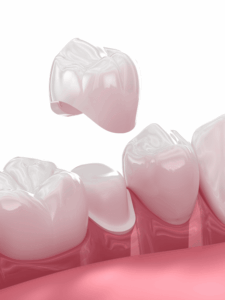Missing teeth can have a profound impact on physical and emotional well-being. Beyond the obvious aesthetic concerns, tooth loss can affect your quality of life, including your ability to eat, speak, and even smile with confidence.
Common causes include tooth decay, traumatic injury, and gum disease (periodontitis), all of which can lead to the eventual loss of one or more teeth. Regardless of the cause, the absence of a tooth creates a gap that can disrupt the delicate balance of your oral health.
The right tooth replacement solution can help restore both the function and appearance of your smile. While dentures and bridges have been traditional options, dental implants, a permanent solution for missing teeth, offer a more complete and lasting restoration.
Follow along to see how dental implants work and the benefits they provide on the path to a perfect smile and a renewed sense of self.
What Are Dental Implants?
Dental implants are not simple artificial teeth; they are a sophisticated system designed to mimic the entire structure of natural teeth, from root to crown.
A dental implant consists of three main parts:
- Implant post – A small, screw-shaped titanium post that is surgically placed into the jawbone to act as the artificial “root” of the missing tooth.
- Abutment – A connector piece that attaches to the implant post and serves as a base for the artificial tooth.
- Crown – A small, screw-shaped titanium post that is surgically placed into the jawbone to act as the artificial “root” of the missing tooth.
A natural tooth has a root that extends into the jawbone, providing stability and stimulating the bone. A dental implant replicates this structure.
The titanium post fuses with the jawbone through a process called osseointegration, creating a strong and stable foundation, just like a natural tooth root. The abutment then connects this foundation to the crown, completing the restoration.
Types of dental implants
- Single tooth implants: Used to replace one missing tooth.
- Implant-supported bridges: Used to replace several missing teeth in a row. They are anchored to implants rather than adjacent teeth.
- All-on-4/All-on-X: A technique used to replace an entire arch of missing teeth (upper or lower) with just four or more implants. Offers a faster and often more cost-effective solution than an implant for every missing tooth.
- Full mouth dental implants :Offer a comprehensive solution for those who have lost all or most of their teeth.
Overview of the treatment process
- Consultation and evaluation: The dentist assesses your oral health, takes X-rays, and creates a treatment plan. Your West Hills implant dentist will conduct a thorough examination to determine your candidacy.
- Implant placement: The implant post is surgically placed into the jawbone.
- Healing and osseointegration: The jawbone heals around the implant, securing it in place. This process can take several months.
- Abutment placement: Once the implant is stable, the abutment is attached.
- Crown placement: The final, custom-made crown is attached to the abutment, completing the restoration.
Top Benefits of Dental Implants
Dental implants offer a wide range of benefits that go beyond simply filling a gap in your smile. They provide a comprehensive solution for restoring oral health, function, and aesthetics. The potential life-changing benefits of dental implants are well-documented.
- Eat, speak, and chew like normal
- No slippage like dentures
- Long-lasting performance under pressure
- Prevents bone loss
- Stimulate the jawbone
- Preserve facial structure over time
- Look and feel like natural teeth
- Customized to match the surrounding teeth
- Feel stable and secure
- No more gaps, awkward chewing, or covering your mouth
- Smile freely in social and professional settings
- With proper care, implants can last decades
- Fewer replacements than bridges or dentures
- Cost-effectiveness over time
Dental Implants vs. Other Tooth Replacement Options
Dentures: Removable appliances that replace all or some of the teeth in one arch.
- Pros: Less expensive initially, non-surgical.
- Cons: Can slip, affect speech, require frequent replacement, do not prevent bone loss.
Dental bridges: Fixed appliances that replace one or more missing teeth by anchoring artificial teeth to adjacent natural teeth.
- Pros: More stable than dentures, less expensive than implants.
- Cons: Require altering adjacent teeth, do not prevent bone loss, shorter lifespan than implants.
Dental implants: Dental implants are a long-lasting, natural-looking solution for replacing missing teeth and restoring full function to your smile.
- Pros: Stable, natural-looking, prevent bone loss, long-lasting.
- Cons: More expensive initially, require surgery, longer treatment time.
Why implants are often considered the “gold standard”
Dental implants offer a combination of stability, longevity, and natural feel that other options cannot match. They are the only tooth replacement option that preserves bone health, making them the preferred choice for many patients and dentists.
Who Is a Candidate for Dental Implants?
Most individuals with missing teeth are candidates for dental implants. Candidates should be in good general health and have healthy gums. Conditions like uncontrolled diabetes or certain autoimmune diseases may affect healing.
Sufficient bone density in the jaw is essential to support the implant. If bone density is inadequate, bone grafting procedures can be used to augment the bone.
There is no upper age limit for dental implants, as long as the patient is in good health. However, younger patients may need to wait until their jawbone has finished growing.
A thorough examination, including x-rays, will be conducted at your consultation. Your dental implant dentist will discuss your medical history, oral health, and treatment goals to determine if dental implants are the right solution for you.
Also Read: Dental Implants: Everything You Need to Know
What to Expect During the Dental Implant Process
The entire dental implant process can take several months, from the initial consultation to the placement of the final crown.
The surgical placement of the implant is typically an outpatient procedure. After placement, the jawbone needs time to heal and fuse with the implant (osseointegration). This healing period, crucial for the implant’s stability, can last several months.
While the implant heals, you may receive a temporary crown or other restoration. Once healing is complete, the permanent, custom-made crown will be attached.
After implant placement, you may experience some discomfort, swelling, or bruising. Your dentist will provide instructions for dental implant recovery, pain management, oral hygiene, and dietary restrictions.
The Best Dental Implants in West Hills
By mimicking the structure of natural teeth and preventing bone loss, dental implants provide a long-term, stable, and natural-looking way to regain a perfect smile.
If you are considering tooth replacement, schedule a consultation today with Dr. Salekian, the top-rated implant dentist at West Hills Smiles.




